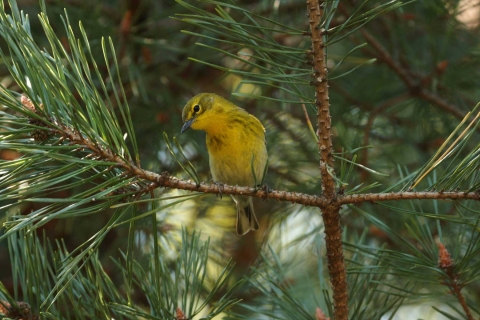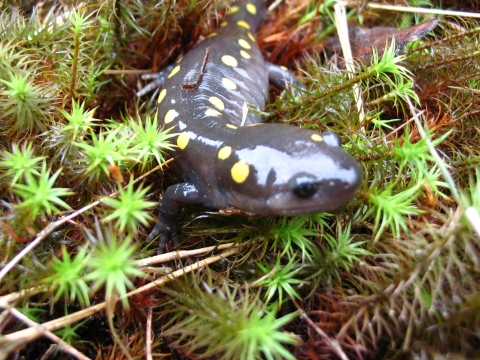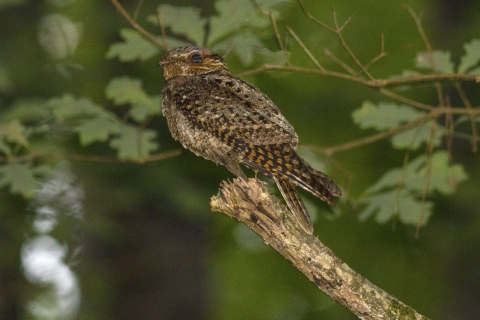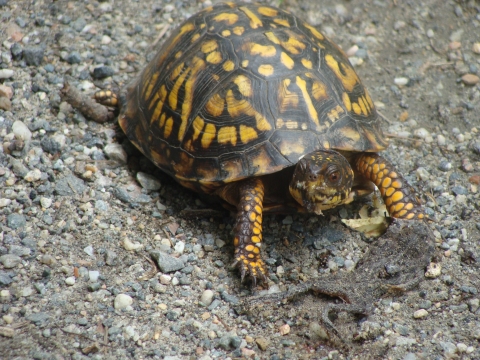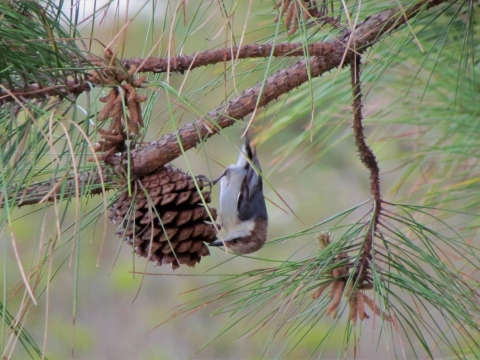Seasons of Wildlife
Visiting the refuge is always a unique experience, with something new to discover depending on the time of day, weather, and season! There are ample opportunities year-round to observe wildlife in their habitats on the refuge. Remember to respect wildlife by observing them from a safe distance and to always leave no trace during your visit. Here’s what to expect with each season on the refuge:
Fall
This is one of the most colorful seasons on the refuge! The leaves on the deciduous trees brighten the refuge with their mosaic of orange, red, and yellow hues. Small mammals begin borrowing in soil or leaf litter to prepare for the the cooler weather. Shorebirds, songbirds, and marsh birds stop at the refuge to fuel up during their long, southward migration along the Atlantic Flyway.
Winter
Wildlife are easy to observe in the winter too! Canada geese can be heard calling from the river or seen flying overhead in a V formation. Black ducks are fond of wintering in the refuge's wetlands and creeks. Bright red cardinals among the evergreen trees provide a striking contrast against the winter snow. The river is a popular wintering spot for bald eagles, with some of the highest concentrations on the east coast located within refuge.
Spring
Spring is when animals and plants awaken! Turtles emerge from the mud and begin basking in the sun. Frogs begin their calls, and playful northern river otters can be spotted along the river looking for food. Early spring season nesting birds begin to emerge. Songs of the secretive grasshopper sparrow can be heard in the early morning!
Summer
The refuge is bustling with activity! A symphony of songs can be heard in the morning from species like warblers and march wren. Northern bobwhite whistle their calls from the grasslands while bald eagles soar overhead, searching for their next meal in the river and its tributaries. Summer is also the peak butterfly season, with warm, sunny weather that sends colorful monarchs, spring azures, southern pearly eyes fluttering through the refuge.
Featured Species
Pine warbler
Pine warblers are migratory songbirds aptly named for their affinity to forage, breed, and nest in pine forests. These small birds winter in the refuge, taking their time to search for berries, insects and seeds in trees and on the forest floor. The mating calls of bright yellow males can be heard early in the year, though its musical trills can be heard through the spring and summer.
Spotted Salamander
Spotted salamanders are fond of the vernal pools and wetland areas of the refuge. They are common throughout eastern United States. These amphibians can grow quite large (6-9 inches!) and are easily identified by their bright yellow/orange spots, however they are quite elusive and spend the majority of their lives under rocks, logs, or burrows.
Bald Eagle
The bald eagle, America’s national symbol, is a large stately bird. Hundreds of eagles utilize the refuge at varying times throughout the year. Adults are easily identifiable by their bright, white head, massive yellow bill, and long white tail feathers. Typically seen perched or flying near large water bodies, these raptors feed on fish, small mammals, and birds. The call of the eagle is a harsh creaking cackle. The refuge currently supports five bald eagle nests and a large roosting population.
Chuck-wills Widow
The Chuck-wills widow is a 12” bird with soft, dark, cryptically patterned feathers, similar to plumage of owls. The bird is active at night, feeding on insects and occasionally on small amphibians. The ground nesting Chuck-wills widow occupies pine forest habitats, preferably in clearings, such as burned or thinned areas. Invisible to most predators, this bird is more often identified by their calls, the four-syllable “chuck-will’-wid’-ow.”
Evidence from national Breeding Bird Surveys suggest that this species is declining throughout their breeding range. James River National Wildlife Refuge population has been increasing since habitat management activities have been employed.
Eastern Box Turtle
The box turtle is so named due its ability to conceal itself in its own shell. With reptilian ancestors that date back millions of years, this species continues to survive today. The adult box turtle is a 4-5” creature well adapted for navigating upland sites. Feeding on both plants and insects, the brightly colored turtle live a relatively solitary life. These turtles hibernate during the cold season and reemerge once warmer temperatures return. The box turtle is able to eat poisonous mushrooms without harm, storing the toxins in their flesh. Predators that eat these turtles could die.
Brown-headed Nuthatch
The brown-headed nuthatch is another small bird keen to spend most of its time in pine forests, hunting for insects up and down tree trunks of southeastern pine forests. Though it is one of the least numerous nuthatch species in North America due to habitat loss, these birds are constantly chattering and can be seen in pairs and groups bouncing from branch to branch. Listen for a squeaky call coming from high in the tree crowns.
